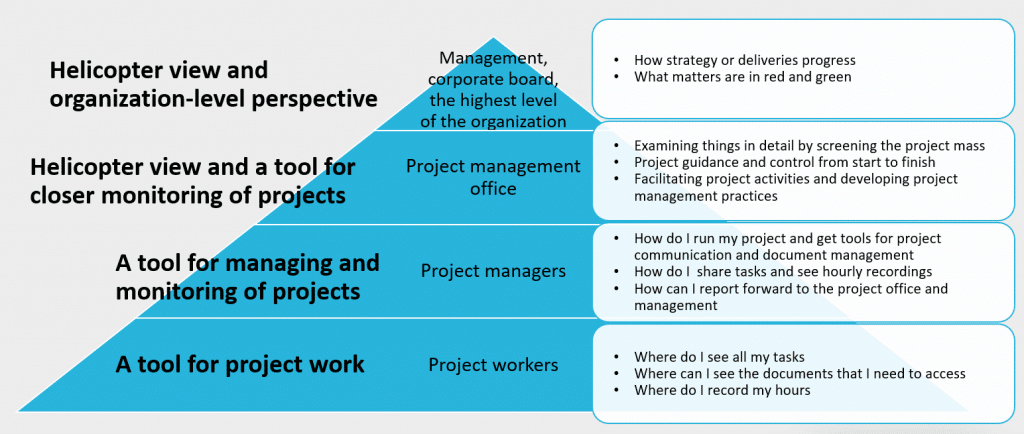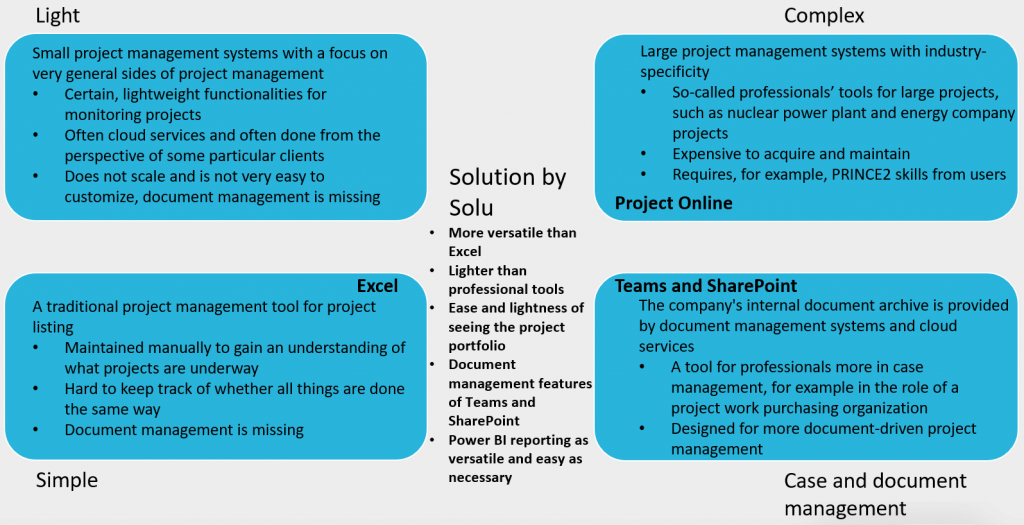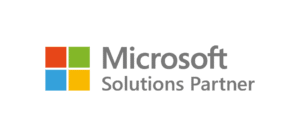Project management is a key part of an organization’s operations. When project management is organized in terms of methods and tools as well as culture, work is enhanced at all levels of the business, from top management to an individual team member.
Project management becomes comparable and transparent at all levels of the organization when individual projects and the project portfolio are managed according to consistent practices with an easy-to-use tool. By documenting processes, roles and tasks, the organization creates its own project manual, which enables the implementation of policies and methods that support the project culture.
Methodological framework for project management culture
There are several methods of project management. The heaviest include PRINCE2 (Projects IN Controlled Environments) and Project Management Professional (PMP), which are process-oriented, certified methods for project management. Their use is often perceived as very bureaucratic and cumbersome, and they are used more in very large-scale projects.
The ABC Project Model, launched by the Project Institute, is widely used in Finland, where projects are classified into implementations of different sizes. In Finland, Tieturi’s V.S.O.P. project model is also used, which divides project management into four different phases: project preparation, planning, implementation control, and finalization. These models provide a lighter framework, for example, in organizations where not that many project management professionals work.
In addition to the ways in which the project culture works, it is worth considering how well the tools can serve all stakeholders in the project work. The pyramid below describes the different levels of organization in project management. Each level has its own role, responsibilities and needs, the consideration of which plays a significant role in the design and development of the project management system.

Cross-wave of project management solutions
The project management systems used in Finland can be roughly divided into four fields. For some, Excel is enough as a simple tool that many organizations start their project work with. Lighter systems, on the other hand, offer standard functionalities for monitoring projects. In some organizations purchasing project work, contract management and documentation are central to the project work. Some industries, such as energy and oil refining and the construction industry, on the other hand, need more robust tools that require users to have professional project management skills such as PRINCE2 or PMP-certified expertise.

At the same time, Solu Digital’s solution is light, but not too simple, nor complicated. Teams and SharePoint enable flexible document management, while we can implement Power BI reporting as simple or diverse as needed for each organization. Using standard Microsoft tools, we can increase the lightness and versatility of the solution just as much as is needed at the moment.
We can make things visible so that they support the project management methodology that the organization may already be using. If there is a conflict between these, the use of the tool will not start so well, or the common methodology will not be followed – which is also not in the interest of the organization. Thus, the solution can be developed in the long run as it grows with the extensions offered by Microsoft 365.
Tailor-made solutions for different industries
Together with Helsinki Regional Transport Authority (HSL), we tailored our project portfolio management application to support the new project methodology and culture, as well as the implementation of projects with a consistent level of quality. The functionalities of the system, which serves project managers and promotes the overall management and internal flow of information, have been expanded to also cover the monitoring of investments and procurements as the operating culture has developed.
Alternatively, our solution also focuses on lighter operations, such as document management from a project work perspective. Our customers have benefited from such a smaller implementation in the construction and property maintenance sectors, among others.
The same Microsoft building blocks have also been used to develop lightweight and easy-to-use solutions for companies specializing in investments and the construction of wind turbines, for example. With small-scale development work, we can build a very industry-specific solution to make it look and feel like the organization’s own.
Towards an organized project culture
The most sensible way is to start building a tool that serves the needs of your own organization and supports the project culture step by step, in small steps. The first step should be light enough for people to get involved and get the change started.
As the steps move forward and people learn to act in the desired way, a certain type of systematics can be added to the tool. Typically, you start looking more closely at projects and the steps required to prepare for them, and the organization’s own project manual begins to take shape. The tool grows most naturally with the manual: the more versatile the manual becomes, the more versatile ways the tool can be used.
At the end of the day, project management culminates in the work people do. If people do not find the tools and practices easy enough, development in the project culture is hardly achievable either. However, it is good to remember that the project culture does not develop in a day – the trip does not have to be done at once, but it is usually worth doing it in pieces.
What does your organization’s project culture look like? Get in touch and let’s see together what kind of journey awaits you!
Jari Kyläjärvi
director
Download the project management guide
Download our guide to smooth project management and make your organization's project work easier. Leave your contact information and we will send the guide to your email.








